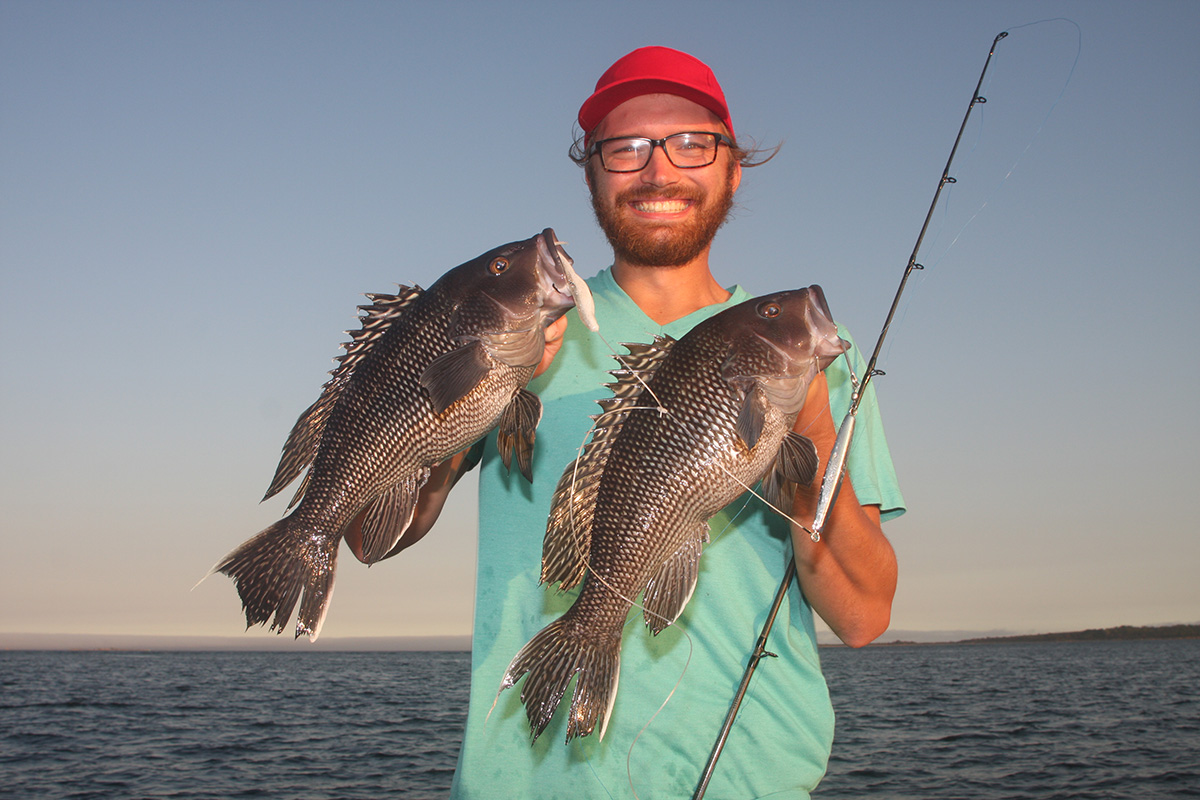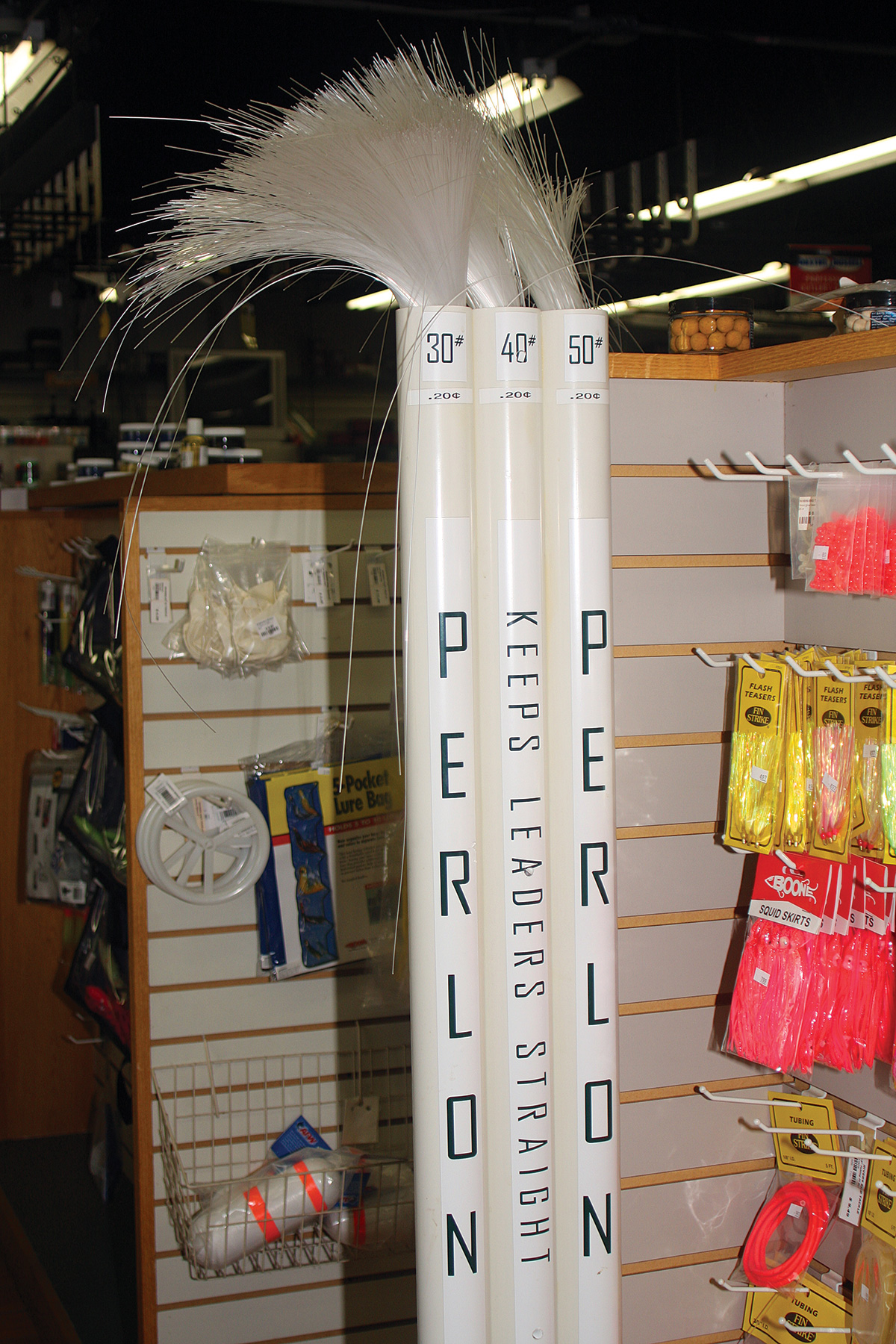
Our three doubles on bruiser sea bass occurred around slack tide, a time notoriously difficult for droppers to work properly, especially when fishing a soft plastic above a diamond jig like we were.
“I’m on,” said my partner Elliott Taylor setting back on another fish as we slowly drifted over the hump, “feels like a keeper.”
A couple minutes later, I slid the net under his 20-inch beauty firmly hooked on the Zoom Salty Super Fluke dropper. “Wow!” I exclaimed. “Seven fish on four drifts. That’s a season best.”
In addition to being on a hotspot, I attributed our success to using a little-known leader material called Perlon, which fills a specific use in leader applications. Popularized in about 2011 and based in Germany, it’s a nylon material like mono but considerably stiffer, therefore making it ideal for many specific uses, including heavy-duty braided watch straps (www.dalucastraps.com/perlon-watch-straps).
Some of the world’s top fishing lines are manufactured from Perlon rather than mono. The reason? When you or a big fish stretch Perlon, it comes back to its original diameter within 3%—even after 400-600 stretches. Why is that important? Many tournament pros re-spool their reels every night during competition because when they get hung up, catch a large fish or set the hook hard, the impact stretches conventional mono. For some uses, of course, one of mono’s preferred features over braided line is its ability to give or stretch. It’s a shock absorber.
Once pulled hard, however, mono remains stretched, so it then has a thinner diameter and up to 25% reduced tensile strength. In other words, your 100-pound mono, once shocked and stretched, may only rate at 75 pounds, and have lower abrasion resistance because it’s now thinner. In contrast, like a rubber band when stretched, Perlon comes back to its original diameter so it will maintain its tensile strength and toughness longer than conventional mono.
According to the linemaker Perlon—The Filament Company (www.perlon.com), which is the world’s leading manufacturer of synthetic monofilaments, Perlon material is offered in a broad range of fishing lines for recreational and competition anglers. The company claims over 1,300 IGFA world records have been achieved using their PerlonXline brand, which sells lines from 0.08 mm to 2.00 mm diameter. According to a description of these lines, they feature high consistency, linear strength, loop strength, knot strength, abrasion resistance and excellent elasticity and wear resistance. But I digress.

That day Elliott and I were slaying knothead sea bass over a deep reef, we were spooled up with 20-pound braided line. The reason is because braid, as you’re likely aware, is ideal for high sensitivity, low drag and zero stretch in deep water—perfect for our needs. But when targeting sea bass, which aren’t fussy, our goal was to have the droppers work optimally, and a heavy Perlon leader was the ideal choice for the business end.
Perlon main line is softer than the leader material, but it’s the leader features we’re interested in here. Perlon leaders are available in some local tackle shops like J&B in Niantic and River’s End in Old Saybrook, CT. Differing from other leaders sold in those shops, Perlon is available in precut, 50-inch straight lengths, making them a bit less convenient than a spool of mono or fluorocarbon leader material, but the lack of pre-coil also helps make them great for leader making. One of the reasons Perlon may be available to anglers in straight shots of 4 feet is its other common use—musical instruments. Nylon is one of the most popular materials for guitar, violin, viola, cello and double bass strings, often specifically Perlon.
J&B sells theirs for about $4.50 for 25 pieces, but you must ask for it. A store worker gladly fetches what you need (in 25-count increments) from the basement. River’s End sells theirs from vertical PVC tubes, and you can buy those individually for about $.20 per strand.
Perlon seems to run thicker than traditional mono. A piece rated at 60-pound at J&B appears comparable in diameter to 80-pound mono, but it’s also nearly twice as rigid.
“Perlon is much more abrasion resistant,” said one of the shop pros at J&B. “I’ve taken a straight-edge razorblade and run it up and down both Perlon and mono, and you get a lot less fraying with Perlon. We use it for custom-tying all our shop-made bottom fish rigs. Besides being much stiffer and wear-resistant, it also has no coil memory.”
I use the super-stiff 60-pound Perlon for all my heavy-duty bottom fishing rigs. Because the material can be difficult to work with given its diameter and rigidness, it’s more challenging to tie a dropper loop with the heavier pound-test (40-pound and above) and impossible to thread the doubled line through a small hook eye. The perfect solution is the blood knot dropper.
Using 60-pound Perlon, tie in a blood knot about 12 inches up, leaving long (6-inch) tag ends. Clip off only one tag end close to the knot. On the other end, clinch on a 2/0-4/0 hook for your soft-plastic or other teaser. The stiffness of the Perlon allows the teaser to remain perpendicular to the main leader, and therefore avoids tangling during the jigging process. Of course, rather than a diamond jig and artificial teaser rig, you could also create a high/low bait rig with a sinker and two blood knots/droppers above the weight. If you prefer not to use a blood knot, you can substitute a suitable three-way swivel, but the additional hardware adds cost and impairs the rig’s “clean” presentation.
Rather than struggling to tie a clinch knot on a short tag end (Four full turns is ideal, if you can achieve it in this material.) to a relatively small hook for bottom fish, I’ve found that metal crimp sleeves—normally used for wire-strand leaders—are ideal for making high/low rigs. I used the Billfisher brand double-sleeve in size 1.3 (100-pack for $8), which was the right fit for 60-pound Perlon. It’s fast and simple, and even works with 1/0 porgy hooks.
The precise pound-test breaking point for Perlon leaders is uncertain. Tackle shops buy it by the pound-test, and sell it that way. In a sense, they’re taking the distributor’s word for its breaking strength.
“In my opinion,” said Capt. Ned Kittredge of Westport, MA, “Perlon is worth exploring for specific bottom fish applications like sea bass, porgy, fluke and tog rigs. The pound-test you choose should be more about diameter, knot tying and performance than true pound-test rating, which is more concerning with the main line. If it’s called 60 but breaks at 90, who cares? If it makes perfect teaser rigs and fits through the hook eye, that’s the goal.”
One bottom-rig manufacturer features big-blackfish rigs specifically touting they’re tied with Perlon. Palmer’s Tackle (www.palmersbucktails.com) makes its all-new heavy Jumbo Tog Rig with 50-pound Perlon hard leader for superior abrasion resistance and less tangle, and they finish it with two Gamakatsu 4/0 octopus hooks.
“Perlon,” said Capt. Q. Kresser, store manager at River’s End Tackle, “can fill a niche for bottom fish guys. The leader is milky color, rather than clear, but down on the bottom those fish don’t really care. It’s perfect for any type of teaser or spreader rig, and it also works well for umbrella rigs because it doesn’t tangle easily. And regarding its opaqueness, remember, the fish are coming from behind the lure or bait to strike it, so they’re seeing a very slim profile from behind the hook. I don’t think its cloudiness matters unless you’re in shallow, clear water with a bunch of educated fish.”
What Q says is true in my experience. Besides having great luck with Perlon on sea bass rigs, I’ve recently switched over all my diamond jig leaders from 80-pound mono to 60-pound Perlon. It coils easier, has no memory when uncoiled, has high abrasion to bluefish teeth and makes a rugged handhold for lifting feisty blues from the water. Fished below braided line, Perlon may be the perfect leader material.



